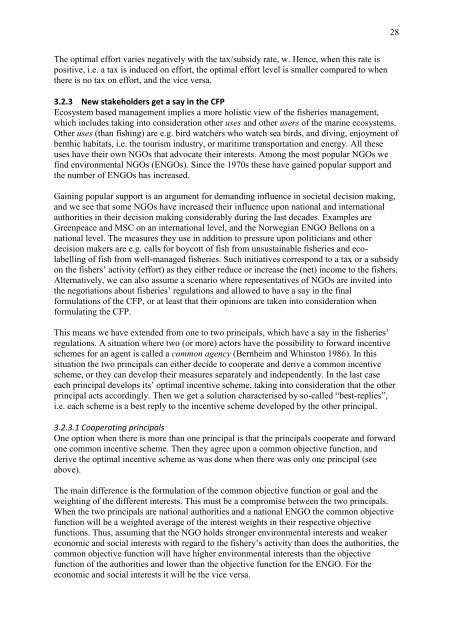Operational tools and adaptive management
Operational tools and adaptive management
Operational tools and adaptive management
You also want an ePaper? Increase the reach of your titles
YUMPU automatically turns print PDFs into web optimized ePapers that Google loves.
The optimal effort varies negatively with the tax/subsidy rate, w. Hence, when this rate is<br />
positive, i.e. a tax is induced on effort, the optimal effort level is smaller compared to when<br />
there is no tax on effort, <strong>and</strong> the vice versa.<br />
3.2.3 New stakeholders get a say in the CFP<br />
Ecosystem based <strong>management</strong> implies a more holistic view of the fisheries <strong>management</strong>,<br />
which includes taking into consideration other uses <strong>and</strong> other users of the marine ecosystems.<br />
Other uses (than fishing) are e.g. bird watchers who watch sea birds, <strong>and</strong> diving, enjoyment of<br />
benthic habitats, i.e. the tourism industry, or maritime transportation <strong>and</strong> energy. All these<br />
uses have their own NGOs that advocate their interests. Among the most popular NGOs we<br />
find environmental NGOs (ENGOs). Since the 1970s these have gained popular support <strong>and</strong><br />
the number of ENGOs has increased.<br />
Gaining popular support is an argument for dem<strong>and</strong>ing influence in societal decision making,<br />
<strong>and</strong> we see that some NGOs have increased their influence upon national <strong>and</strong> international<br />
authorities in their decision making considerably during the last decades. Examples are<br />
Greenpeace <strong>and</strong> MSC on an international level, <strong>and</strong> the Norwegian ENGO Bellona on a<br />
national level. The measures they use in addition to pressure upon politicians <strong>and</strong> other<br />
decision makers are e.g. calls for boycott of fish from unsustainable fisheries <strong>and</strong> ecolabelling<br />
of fish from well-managed fisheries. Such initiatives correspond to a tax or a subsidy<br />
on the fishers‟ activity (effort) as they either reduce or increase the (net) income to the fishers.<br />
Alternatively, we can also assume a scenario where representatives of NGOs are invited into<br />
the negotiations about fisheries‟ regulations <strong>and</strong> allowed to have a say in the final<br />
formulations of the CFP, or at least that their opinions are taken into consideration when<br />
formulating the CFP.<br />
This means we have extended from one to two principals, which have a say in the fisheries‟<br />
regulations. A situation where two (or more) actors have the possibility to forward incentive<br />
schemes for an agent is called a common agency (Bernheim <strong>and</strong> Whinston 1986). In this<br />
situation the two principals can either decide to cooperate <strong>and</strong> derive a common incentive<br />
scheme, or they can develop their measures separately <strong>and</strong> independently. In the last case<br />
each principal develops its‟ optimal incentive scheme, taking into consideration that the other<br />
principal acts accordingly. Then we get a solution characterised by so-called “best-replies”,<br />
i.e. each scheme is a best reply to the incentive scheme developed by the other principal.<br />
3.2.3.1 Cooperating principals<br />
One option when there is more than one principal is that the principals cooperate <strong>and</strong> forward<br />
one common incentive scheme. Then they agree upon a common objective function, <strong>and</strong><br />
derive the optimal incentive scheme as was done when there was only one principal (see<br />
above).<br />
The main difference is the formulation of the common objective function or goal <strong>and</strong> the<br />
weighting of the different interests. This must be a compromise between the two principals.<br />
When the two principals are national authorities <strong>and</strong> a national ENGO the common objective<br />
function will be a weighted average of the interest weights in their respective objective<br />
functions. Thus, assuming that the NGO holds stronger environmental interests <strong>and</strong> weaker<br />
economic <strong>and</strong> social interests with regard to the fishery‟s activity than does the authorities, the<br />
common objective function will have higher environmental interests than the objective<br />
function of the authorities <strong>and</strong> lower than the objective function for the ENGO. For the<br />
economic <strong>and</strong> social interests it will be the vice versa.<br />
28

















